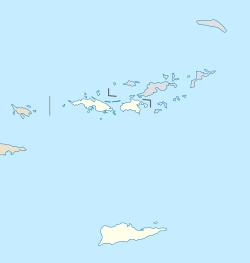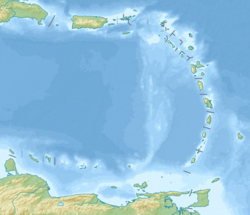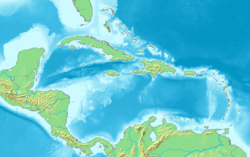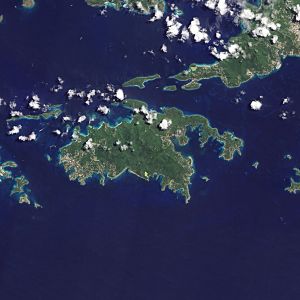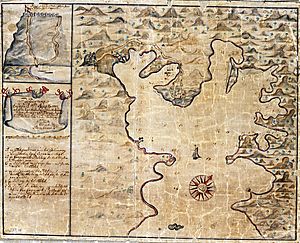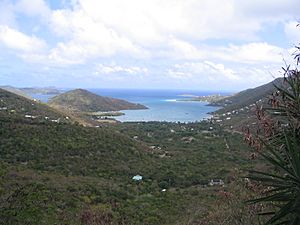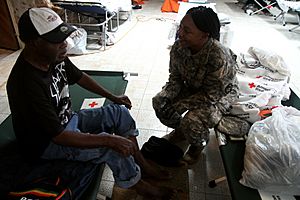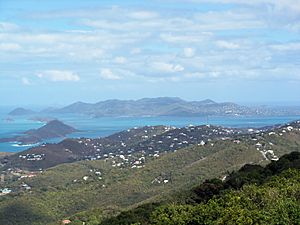Saint John, U.S. Virgin Islands facts for kids
|
Nickname: Love City
|
|
|---|---|
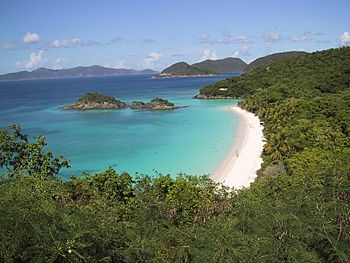
Trunk Bay, St.John, U.S. Virgin Islands
|
|
| Geography | |
| Location | Caribbean Sea |
| Coordinates | 18°20′N 64°44′W / 18.333°N 64.733°W |
| Archipelago | Virgin Islands, Leeward Islands |
| Area | 20 sq mi (52 km2) |
| Administration | |
| Insular area | United States Virgin Islands |
| District | Saint John |
| Largest settlement | Cruz Bay (pop. 2,706) |
| Demographics | |
| Population | 4,170 (2010) |
| Pop. density | 82.09 /km2 (212.61 /sq mi) |
| Additional information | |
| Shimika Jones is the Administrator of St. John since 2019. She was appointed by Governor Albert Bryan. | |
Saint John (also called Sankt Jan in Danish) is a beautiful island in the Caribbean Sea. It is part of the United States Virgin Islands (USVI), which is a territory of the United States.
Saint John is the smallest of the three main US Virgin Islands. It covers about 50 square kilometers (20 square miles). The island is located near Saint Thomas, where the capital city, Charlotte Amalie, is found. It's also close to Tortola, which is part of the British Virgin Islands.
The biggest town on Saint John is Cruz Bay, with about 2,700 people. Many people call Saint John "Love City" because of its friendly atmosphere.
A large part of the island, about 60%, is protected as Virgin Islands National Park. This park is managed by the United States National Park Service. The island's economy mostly relies on tourism and businesses that support visitors.
In 2010, Saint John had a population of 4,170 people. The total population of the US Virgin Islands was 106,405. Most residents are of Afro-Caribbean descent.
Contents
Island History
Early People
Long ago, from about 700 to the late 1400s, the Taíno people lived on Saint John. We know this from ancient carvings called Petroglyphs and other items found at Cinnamon Bay.
European Arrival
In 1493, Christopher Columbus sailed past Saint John during his second voyage. He named the northern Virgin Islands Las Once Mil Virgenes, meaning "The Eleven Thousand Virgins." However, he did not land on Saint John.
Danish Settlement
In 1671, the Danish West India Company settled on Saint Thomas. Then, in 1717, about 20 Danish farmers came from Saint Thomas to Saint John. At that time, no one lived on Saint John.
These farmers started growing crops like sugar cane and cotton. By 1731, the Annaberg sugar plantation was built. It became one of the island's largest sugar producers. By 1733, there were 109 plantations on the island. In 1754, the islands became a crown colony, meaning they were directly ruled by the Danish king.
Slave Revolt of 1733
A major event in Saint John's history was the 1733 slave insurrection on St. John. It began when a small group of enslaved people entered Fort Frederiksvaern, a Danish fort. They used hidden tools to overpower the soldiers.
This act signaled the start of a six-month revolt. The enslaved people, many from the Akwamu group, fought for their freedom. The revolt finally ended when French troops arrived from Martinique. Rather than be captured, some of the leaders, including a woman named Breffu, chose to end their own lives.
Changes Over Time
In 1749, the Moravian Brethren built the first church at Emmaus. The town of Cruz Bay was founded in 1766.
By 1804, the number of enslaved people reached its highest point, with 2,604 individuals. Denmark ended slavery in 1848. After this, many plantations were left empty. By 1901, Saint John's population was only 925. The last sugar factory on the island closed in 1908.
U.S. Purchase
In 1917, during the First World War, the United States bought the U.S. Virgin Islands from Denmark for $25 million. The U.S. wanted to create a naval base there. This was to help prevent the German Empire from expanding into the Western Hemisphere. As part of this deal, the U.S. agreed to recognize Denmark's claim to Greenland.
During the 1900s, private investors bought land on the island. They turned some old plantation houses into vacation resorts. One famous example is Laurence Rockefeller's Caneel Bay Resort. The islands became popular for tourists. Tourism and related jobs became a very important part of the economy.
Hurricane Irma
In September 2017, Hurricane Irma hit Saint John. This was a very strong storm, a Category 5 hurricane. It caused about half of the island's 4,500 residents to leave their homes. Power outages lasted for many months across the island.
Government and Leadership
Since 1917, the U.S. Virgin Islands have been an organized, unincorporated territory of the United States. This means that people living there are U.S. citizens. However, they cannot vote in presidential elections.
Until 1970, the US President chose the governors of the territory. But since then, island residents have been able to elect their own governor and lieutenant governor. They also elect fifteen senators to the local legislature. Seven senators are from Saint Croix, seven are from Saint Thomas and Saint John, and one senator must live on Saint John. These senators serve for two years.
Residents of the Virgin Islands also elect a delegate to the US Congress. This delegate can speak in Congress but does not have a vote.
Saint John does not have its own local government. However, the Governor appoints an administrator for the island. This person acts as an adviser to the Governor and speaks for the Governor's plans on the island.
The main political parties in the U.S. Virgin Islands are the Democratic Party, the Independent Citizens Movement (ICM), and the Republican Party. Some people also run for office without belonging to a party.
Island Economy
In the past, the main product from Saint John was sugar cane. This was grown in large amounts using the labor of enslaved people from Africa and India. However, this industry declined after slavery was ended. It was no longer profitable without free labor. Also, sugar from other places, like sugar beets, became competition.
Tourism Today
Today, Saint John's economy mostly depends on tourism. The island has many rental villas, hotels, and resorts for visitors. You can find many shops and restaurants in Cruz Bay and Coral Bay. These places serve both locals and tourists.
Saint John is a popular spot for boat trips from the U.S. Virgin Islands, Puerto Rico, and the British Virgin Islands. Many boat tours are available. People enjoy island hopping to places like Jost Van Dyke, Tortola, and Norman Island. There are also many places to anchor boats around Saint John for day trips or overnight stays.
Virgin Islands National Park
In 1956, a man named Laurance Rockefeller gave a lot of his land on the island to the National Park Service. He did this with one important rule: the land must be protected and not developed in the future. The famous Caneel Bay Resort operates on land leased from the National Park Service, which owns the property.
The Virgin Islands National Park covers about 75% of the island. However, some private lands inside the park boundaries mean that the park actually owns about 60% of the island.
Much of the island's waters, coral reefs, and shorelines are protected within the national park. This protection grew even more in 2001 when the Virgin Islands Coral Reef National Monument was created.
Getting Around Saint John
Saint John does not have its own airport. People usually fly into Cyril E. King Airport on nearby Saint Thomas. In the past, there was a seaplane base in Cruz Bay, but it is no longer in use.
You can get to Saint John by ferry. Ferries run every hour from Red Hook, St. Thomas. There are also ferries from Charlotte Amalie, St. Thomas and from Tortola. Other ferries connect Saint John to islands like Virgin Gorda and Jost Van Dyke.
Cars and other goods are brought to the island by large boats called barges. Two companies offer barge service between Red Hook, St. Thomas, and Cruz Bay, Saint John. These barges run hourly during the day.
You can rent cars in Cruz Bay, usually close to the ferry dock. Taxis are also easy to find on Saint John. They can take you to beaches, hotels, and vacation homes. There is also a public bus service called VITRAN that runs hourly on weekdays between Cruz Bay and Salt Pond Bay.
Images for kids
See also
 In Spanish: San Juan (Islas Vírgenes) para niños
In Spanish: San Juan (Islas Vírgenes) para niños


